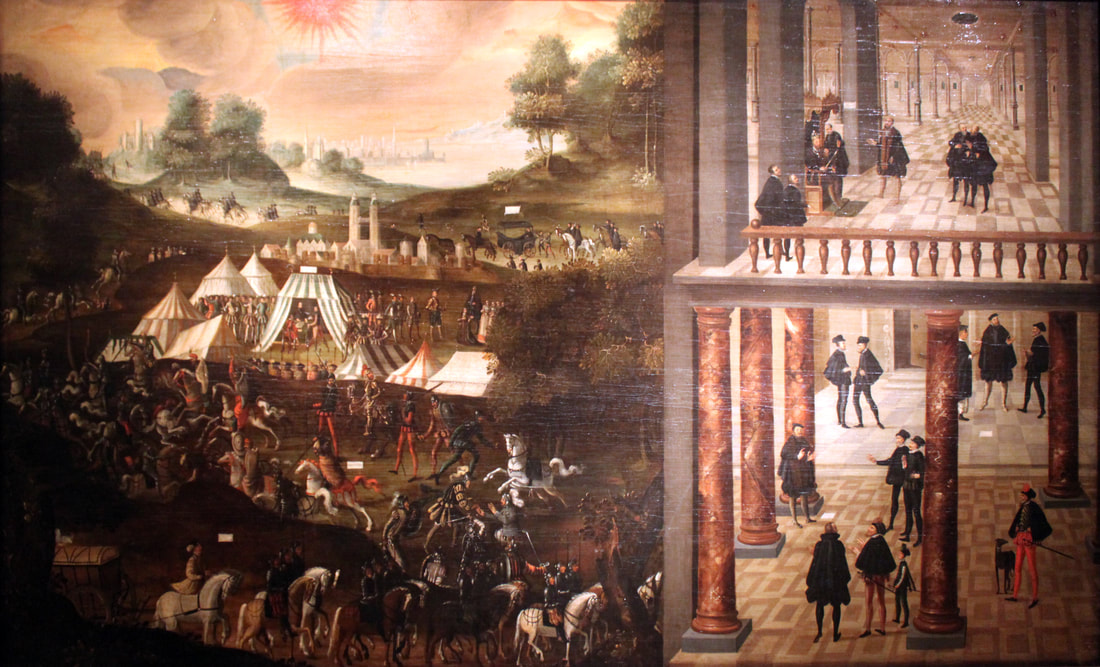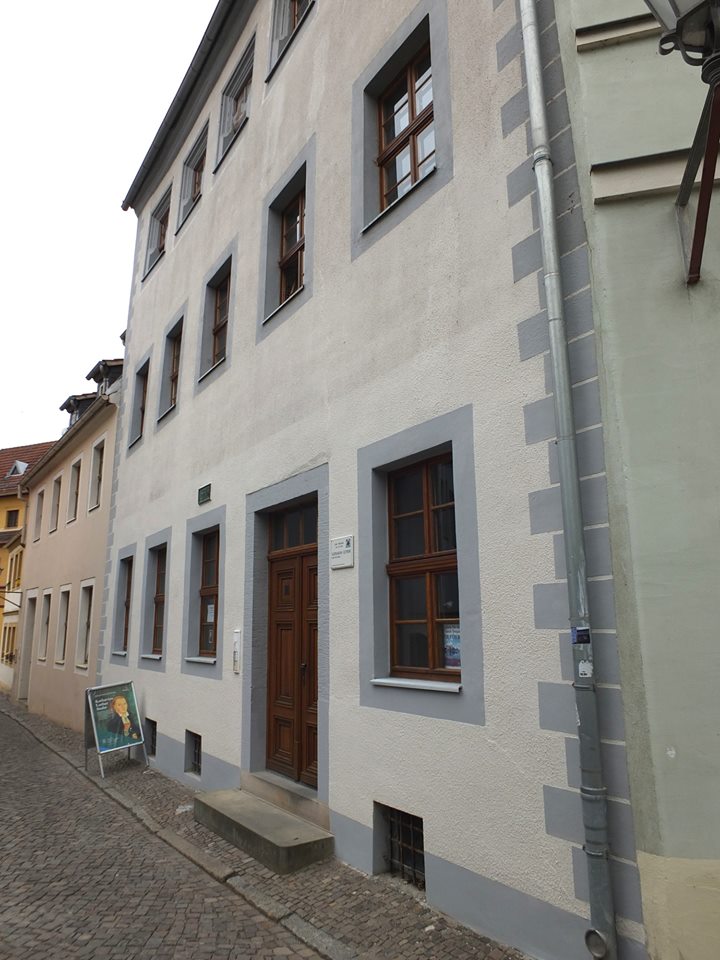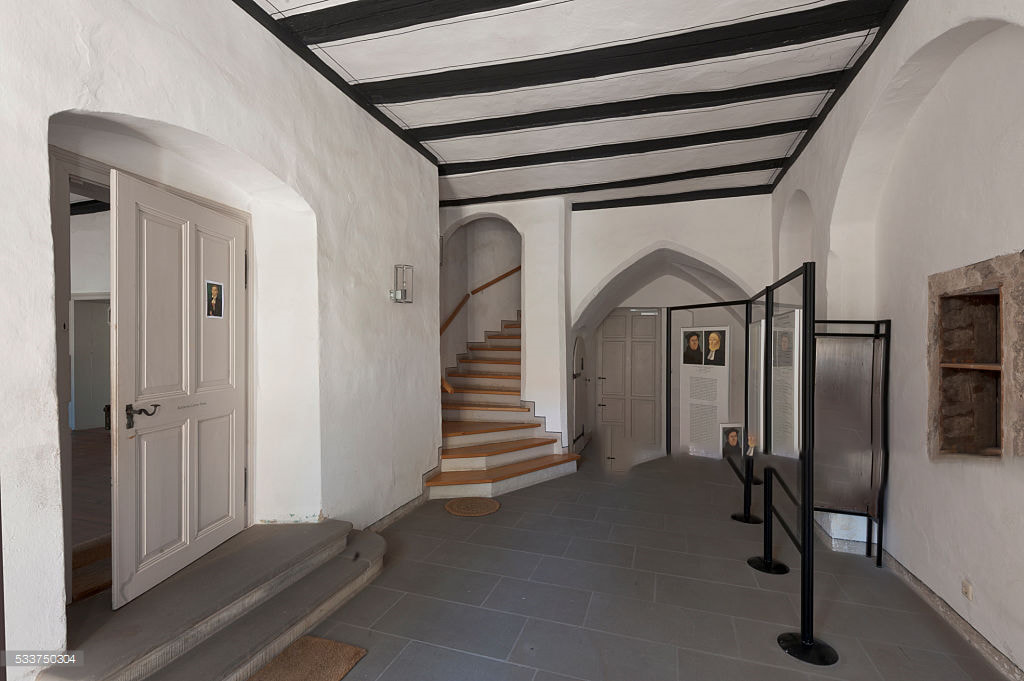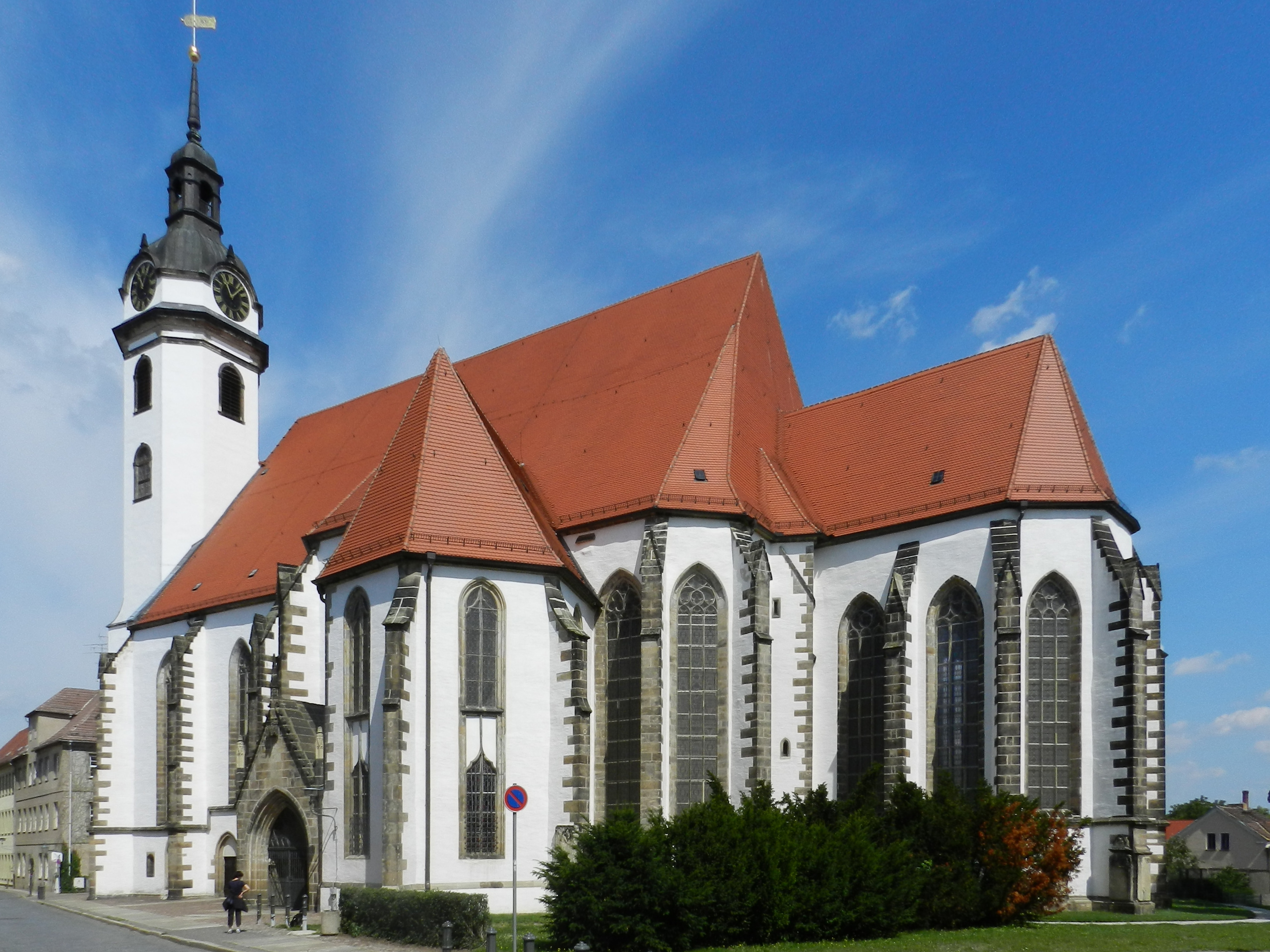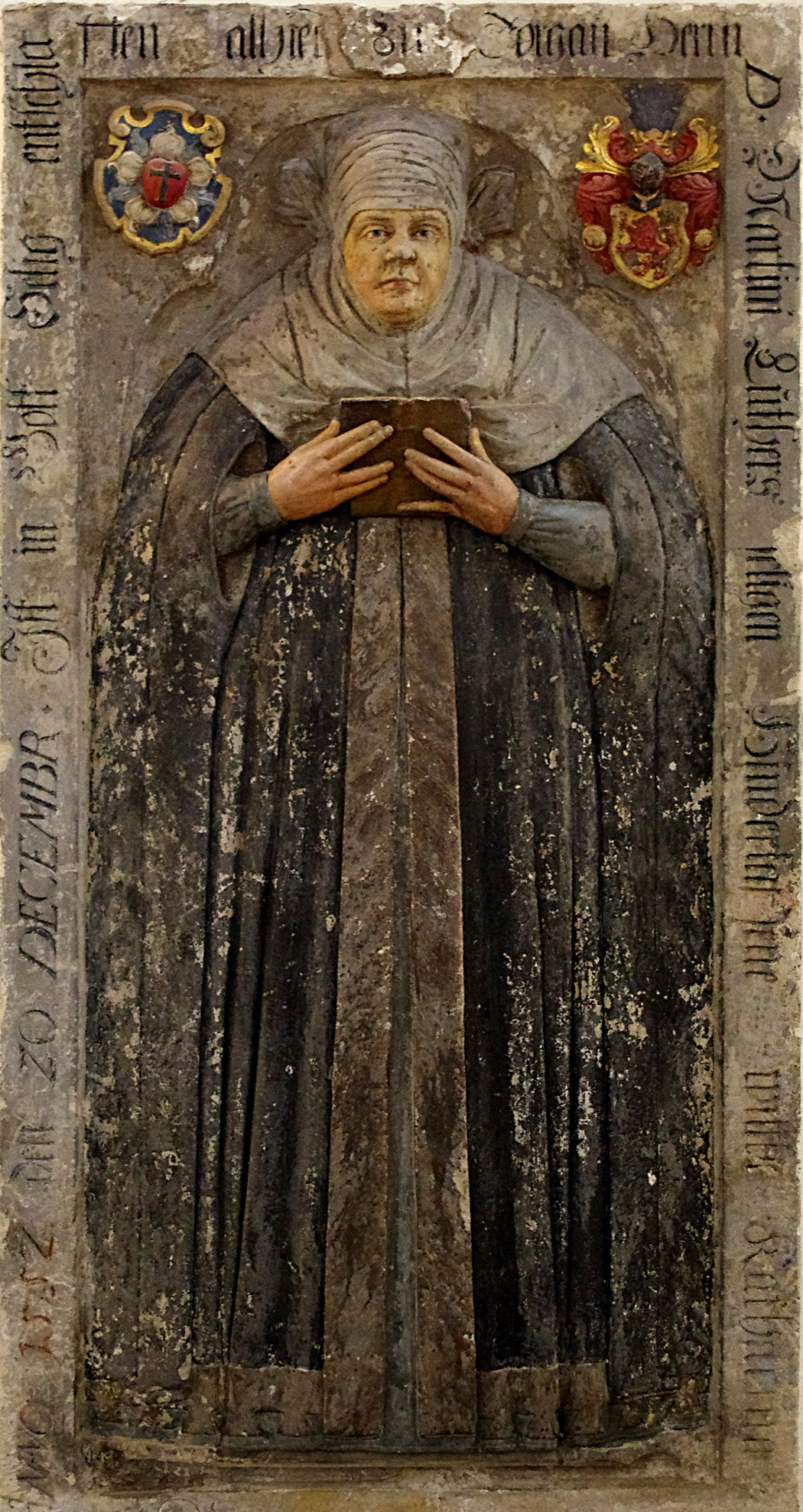Life After Luther
There is no universal agreement on the approximate or exact date the Protestant Reformation ended. Historically, the Peace of Westphalia is considered to be the event that ended the Reformation. It has also been said that the Reformation ended in the mid 18th century. Some argue that the Reformation never ended as new groups splintered from the Catholic Church as well as all the various Protestant churches that exist today. The Roman Catholic Church responded with the so-called Counter-Reformation initiated by the Council of Trent. In general, Northern Europe, with the exception of most of Ireland, came under the influence of Protestantism. Southern Europe remained Roman Catholic, while Central Europe was a site of a fierce conflict, culminating in the Thirty Years' War, which left it devastated.
|
About April 1546 - Two months after Luther's death, a heartbroken Katharina wrote her sister that everyone with any sort of heart must be mourning her dead husband. She could not eat or sleep, and she was so disoriented that she was unable to write or dictate her letter in an orderly manner. To her Martin Luther was "this dear and precious man."
Emperor Charles Strikes a Non-Fatal Blow
November 1546 - The Schmalkaldic War broke out between the forces of Emperor Charles V and the Lutheran Schmalkaldic League. With the troops of Emperor Charles advancing, Wittenberg University was temporarily dissolved. Philipp Melanchthon and his family fled 32 miles west to the city of Zerbst in Anhalt and Katharina Luther and her children followed him. Katharina returned to Wittenberg a few weeks later. Again she turned her home into a hostel, taking in both professors and students to provide an income. With the help of Melanchthon, who was appointed as her guardian, she attempted to win back her confiscated property and rights. She petitioned Christian II, the King of Denmark, to continue sending the annual payments of fifty Gulden received by her husband, to which he agreed. April of 1547 - Katharina again fled Wittenberg, this time to Braunschweig, intending to go to Copenhagen to seek asylum with the king of Denmark. But the wagon with her and the children had to turn back north of Lüneburg, about 184 miles northwest of Wittenberg. April 24, 1547 - At the Battle of Mühlberg in Saxony, the Catholic princes led by Emperor Charles V and the Duke of Alba decisively defeated the Schmalkaldic League of Protestant princes under the command of Elector John Frederick I of Saxony and Landgrave Philip I of Hesse. Over 7,000 men died or were wounded and 1,000 were taken prisoner. May 19, 1547 – So as not to lose time by laying siege to Wittenberg, Emperor Charles chose to negotiate with Elector John Frederick. To save his wife and sons, and to prevent Wittenberg from being destroyed, John signed the Capitulation of Wittenberg, and resigned his title in favor of his cousin Maurice. Two days later Charles V entered Wittenberg. A rumor spread that while he stood in front of Luther's tomb in the Castle Church he was urged to have Luther's body dug up burned and his ashes scattered. Reportedly Charles replied, "I don't make war against dead men."
Late fall, 1547 - At the close of the war Katharina was able to return to Wittenberg, only to find the buildings and lands of the Black Cloister torn apart and laid waste. Her farm animals had been stolen or killed. The two flights exhausted the family's cash reserves, but with hard work Katharina got back on her feet. She obtained scholarships for her sons from the Dukes of Prussia and Württemberg. May 15, 1548 - After defeating the Protestant Schmalkaldic League Emperor Charles V established a provisional ruling on the religious strife between Lutherans and Catholics known as the Augsburg Interim. It ordered Protestants to readopt traditional Catholic beliefs and practices, including the seven Sacraments, transubstantiation and the authority of the pope . But, it allowed for Protestant clergymen the right to marry and for the laity to receive both bread and wine at communion.. It is considered the first significant step in the process leading to the political and religious legitimization of Protestantism. Despite the fact that Philip Melanchthon was willing to compromise for the sake of peace, the Augsburg Interim was rejected by a significant number of Lutheran pastors and theologians. Many Catholic princes did not accept the Interim because of their concern for rising imperial authority. The pope refused to recognize the Interim for over a year as he saw it as an infringement of his jurisdiction. Charles V tried to enforce the Interim in the Holy Roman Empire, but was only successful in territories under his military control. October 1551 – Due to increased debts Katharina took out a mortgage on her farm in Zulsdorf, near Leipzig. January 1552 - Elector Maurice of Saxony, known as the "Judas of the Reformation" for changing sides at Mühlburg, switched sides again. Under his leadership, he and his fellow German princes formed an alliance with Henry II of France and chased Charles V out of Germany and back to his ancestral home in Austria. August 2, 1552 - Weary from three decades of religious civil war, Charles V agreed to the Peace of Passau guaranteeing Lutheran religious freedoms. The Protestant princes taken prisoner during the Schmalkaldic War were released. The Peace effectively ended Charles V's lifelong quest to reunify the Catholic Church. Summer 1552 – An outbreak of the Black Plague forced Wittenberg University to move to Torgau. Katie Luther was determined to stay in the Black Cloister as long as possible. Finally, in September, the plague came to her house. Hans was at school in Königsberg and Martin may have been studying in Wittenberg. Katie boarded a carriage with Paul and Margaretha and headed for Torgau. Along the way, something startled the horses and they shied. Katie attempted to jump from the carriage to settle the horses and protect her children. Jumping from the carriage she fell, ending up in a ditch full of freezing water. Paul and Margaretha managed to get their mother to Torgau. But the fall and her injuries, along with shock from the cold water lead to paralysis. Katie was bedridden for three months, attended by Margaretha, Paul brought her happy news when he announced his marriage to Anna von Warbeck. In her last days, Katie frequently entrusted her children to God’s care and the faith her husband had fought so hard for. Finally, the injuries and accompanying illness became too much and she died, one month shy of her 54th birthday.. Legend claims that as she lay dying, she was asked about her faith. She replied that she would “cling to Christ as a burr to a dress”. Katie was buried in Torgau's Saint Mary's Church, 47 miles from her husband's tomb in Wittenberg. After the death of Katharina, the Black Cloister in Wittenberg was sold back to the university.
At the time of Katie's death her surviving children were adults.
January 1552 - Princes' War: Led by Elector Maurice of Saxony, many Protestant princes formed an alliance with Henry II of France at the Treaty of Chambord. In return for French funding and assistance, Henry was promised lands in western Germany. Emperor Charles V was driven out of Germany to his ancestral lands in Austria, Elector Maurice returned to Saxony. No longer seen as a traitor, both Protestants and Catholics rendered him equal respect. The emperor exhorted both parties to maintain peace in his empire.
July 9, 1553 - At the Battle of Sievershausen in Germany, Elector Maurice defeated his former ally Albert, But he was badly wounded in the stomach and died in a field camp at the age of 32. September 25, 1555 - Peace of Augsburg was the first permanent legal basis for the coexistence of Lutheranism and Catholicism in Germany, by the Diet of Augsburg. The Peace allowed the princes to select either Lutheranism or Catholicism as the religion of their domain and permitted those who adhered to the other church could sell their property and migrate to a territory where that denomination was recognized. The legislation officially ended conflict between Catholics and Lutherans, though it made no provisions for other Protestant denominations, December 4, 1563 - Final session of the Council of Trent which took place between 1545 and 1563 in Trento (Trent) and Bologna, northern Italy. It was one of the Roman Catholic Church's most important councils. Prompted by the Protestant Reformation, it has been described as the embodiment of the Counter-Reformation. Charles V had wanted abuses looked at first in an attempt to please the Protestants and hopefully tempt them back to the church. Once they were back they could look at doctrine. Paul III did not want this as reforms could financially damage him and concessions could diminish his authority.
By the end of the century, many of the abuses that motivated the Protestant Reformation disappeared, and the Roman Catholic Church reclaimed many of its followers in Europe. The council, however, failed to heal the schism that divided the Western Christian church. 1618–1648 - The Thirty Years War was in reality a series of wars fought by various nations for various reasons, including religious, dynastic, territorial, and commercial rivalries. Its destructive campaigns and battles occurred over most of Europe Although the struggles that created it erupted some years earlier, the war is held to have begun in 1618, when the future Holy Roman emperor Ferdinand II attempted to impose Roman Catholicism on his domains, and the Protestant nobles of Bohemia and Austria rose up in rebellion. After a five-year struggle Ferdinand won. In 1625 King Christian IV of Denmark saw an opportunity to gain valuable territory in Germany to balance his loss of Baltic provinces to Sweden. Christian’s defeat finished Denmark as a European power, but Sweden’s Gustav II Adolf invaded Germany and won many German princes to his anti-Roman Catholic cause. Meanwhile the conflict widened, fueled by political ambitions of the various powers. Poland pushed its own ambitions by attacking Russia and establishing a dictatorship in Moscow. The Peace of Polyanov in 1634 ended Poland’s claim to the Russian throne but freed Poland to resume hostilities against its archenemy, Sweden, which was deeply embroiled in Germany. Here, in the heartland of Europe Roman Catholicism, Lutheranism, and Calvinism vied for dominance. The principal battlefield for all these conflicts was the towns and principalities of Germany, which suffered severely. During the war, many of the contending armies were mercenaries, many of whom could not collect their pay. Thus began the “wolf-strategy” that typified this war. The armies plundered as they marched, leaving cities, towns, villages and farms ravaged. When the contending powers finally met in the German province of Westphalia to end the bloodshed, the balance of power in Europe had been radically changed. Spain had lost not only the Netherlands but its dominant position in western Europe. France was now the chief Western power. Sweden had control of the Baltic. The United Netherlands was recognized as an independent republic. The member states of the Holy Roman Empire were granted full sovereignty. The long-standing notion of a Roman Catholic Europe, headed spiritually by a pope and temporally by an emperor, was permanently ended, and the essential structure of modern Europe as a community of sovereign states was established. When the war ended the map of Europe had been irrevocably changed. May and October 1648 - Peace of Westphalia, a series of treaties, ended the Thirty Years' War It's two main tenets were:
Roman Catholics and Protestants alike, ignored him... If a pebble dropped in a pool of water sends out ripples, then the Reformation was like a fiery meteor slamming into a body of water, sending out waves of titanic proportions. In their aftermath those waves have shaped the lives of people and nations. They redirected economic, political, and social pathways. They created inroads where there were none, and washed over those who tried to stop it. Its waves continue to surge today. |
Timeline1547 --
1648 --
Maurice (1521-1553), duke and later elector of Saxony, whose clever manipulation of alliances and disputes gained the Albertine branch of the Wettin dynasty extensive lands and the electoral dignity.
Maurice succeeded his father, Duke Henry of Saxony, in 1541. Although a Protestant, he aided the Roman Catholic emperor Charles V against the forces of Suleiman the Magnificent of the Ottoman Empire. In 1545, Maurice refused to join the Protestant Schmalkaldic League, although Landgrave Philip of Hesse, his father-in-law, was its leader. Maurice returned to Charles’s camp and conquered electoral Saxony. Ousted in 1547, he returned after the defeat of the Schmalkaldic League in the Battle of Mühlberg (1547) and received the electoral dignity and sizable lands. Soon Maurice began to resent Charles’ plans to reintroduce Catholicism in Germany’s Protestant territories and the continued imprisonment of his father-in-law, Philip the landgrave of Hesse, whose freedom Charles had guaranteed. Commissioned to capture the rebellious Lutheran city of Magdeburg, Maurice seized the occasion to raise an army. In March 1552 he overran southern Germany and parts of Austria, forcing the Emperor to flee and release Philip. In August 1552 the Lutheran position was provisionally guaranteed by the Treaty of Passau. Again returning to the Emperor’s camp, Maurice campaigned against the Turks in Hungary. Finally, in northwestern Germany, he confronted his former ally Albert II of Brandenburg, who had rejected the Peace of Passau. He defeated Albert at Sievershausen but died of wounds sustained in the battle. Did you know?
Reflections
|

